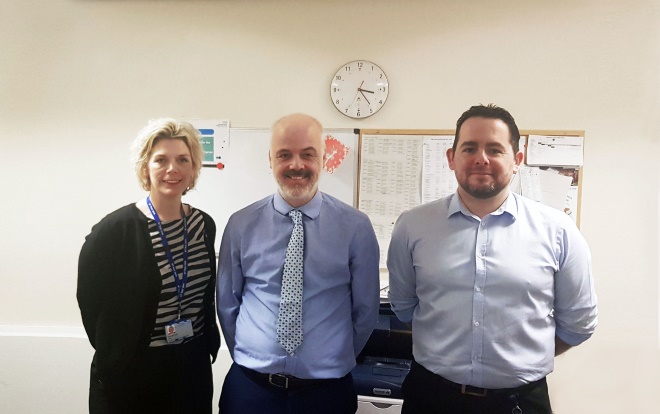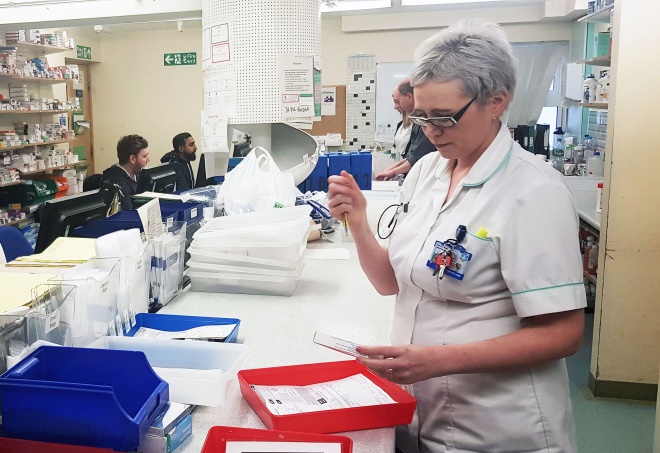
JL / The Pharmaceutical Journal
Sitting in the waiting room of Royal Albert Edward Infirmary’s pharmacy, it is hard to imagine that, as a result of the medicines incident reporting work going on in this small, modest building, Wrightington, Wigan and Leigh (WWL) NHS Foundation Trust is outperforming some of the largest trusts in the North West.
In 2014, WWL was in the lowest quartile of trusts in England for medicines incident reporting. Within just one year, it had increased its reporting by a dramatic 139%.
As chief pharmacist Mike Parks busies himself making cups of coffee in the office he shares with his senior management colleagues, he insists that the credit for this achievement should not go to him, but to his dedicated team.
He describes how, over the past few years, the trust has introduced several new safety initiatives led, primarily, by the pharmacy team. These initiatives include the development of an open culture where errors can be reported without fear of blame and where errors are fully investigated, and all staff involved have an opportunity for reflective learning. This has resulted in improved communication about errors within the pharmacy department, throughout the trust, and with local clinical commissioning groups (CCGs) and other trusts.
“We were set a 14% increase [for medicines incident reporting] by our CCG and within a year we had achieved over a 100% increase,” explains Parks.
We became … one of the top trusts for reporting medicines errors and events in the North West — we went from the bottom to the top in a very short space of time
“We became … one of the top trusts for reporting medicines errors and events in the North West — we went from the bottom to the top in a very short space of time.”
The trust is able to assess its progress via the National Reporting and Learning System, a central database of patient safety incident reports, which enables trusts to see how they compare with others.
Parks was appointed chief pharmacist in December 2013 and, soon after, he set up a senior management group comprising himself, two deputy chief pharmacists — Gary Masterman, who manages the governance team, and Jonathan Peacock, who manages clinical services — and chief pharmacy technician Rachel Ball, who is in charge of the operational team.
Parks’s aim was to re-energise the management of the department, improve the incident reporting culture across the trust and, consequently, improve medicines — and patient — safety. Now, the trust reports in excess of 80 no-harm medication incidents each month.

Source: Courtesy of Mike Parks
From left to right: chief pharmacy technician Rachel Ball, chief pharmacist Mike Parks and deputy chief pharmacist Gary Masterman
Developing a ‘no blame’ culture
The first thing the senior management group did was to try to instigate what the NHS calls a ‘just culture’, both within the pharmacy and across the hospital, explains Peacock. This means creating an environment in which staff feel they can confidently report errors without fear of the potential consequences for themselves or their colleagues.
“We use a system from Datix [for reporting errors],” explains Peacock. “No names are put in, just your role.”
The trust has used the Datix incident-reporting software for a while but in the past the process was viewed negatively and, as a result, people did not use it consistently.
One of the initial challenges was to find a way to change how staff perceived the system, from something that could result in blame and penalisation to something that could potentially offer a valuable lesson, not just for the person who made the error but for the entire trust.
“You don’t ‘Datix someone’. You report an error that has happened in the organisation, which you, as an organisation, want to fix. [That’s] whether it is something directly related to pharmacy, or is nurse or doctor related,” explains Peacock.
“[Then you ask] is there an education piece that could be done?
“[It’s about] letting us identify the problem and fix it,” he says. “By seeing that, and seeing what happens when you report an error, you get a lot more engagement around it.”
Peacock says that pharmacy staff are presented with the concept of a just culture on the first day of their corporate induction.
“We have a policy in place that says what we’ll do if you make an error — it’s crystal clear.”
As part of the process for dealing with errors, the team sends out a reflective learning sheet to be completed by everyone involved, which enables them to determine whether there is anything that can be done to help reduce the risk of that same error occurring again.
“It’s all well and good us making suggestions, but if you made that error … you may have thought of something we haven’t,” says Kim Weall, a medicines safety pharmacist.
“Some [of the reflections we’ve received] are really interesting and helpful — it gives people a second to think about what actually happened.”
We all do things wrong but you can learn from your experiences
A major focus of the pharmacy team’s approach to resolving errors is to provide support to the person responsible.
“We all do things wrong but you can learn from your experiences,” says Weall.
The development of this culture of ‘no blame’ and support has resulted in an increase in incident reporting across the organisation.
“We report [the incident] at board level, along with the people who discovered it. It’s very much about ownership and making sure that the person involved in the incident is aware of it,” explains Masterman.
“Generally, the incidents are categorised into various themes. If we see a run of particular errors, we will run that as a theme,” he adds.
Medicines safety is a feature in the trust’s local groups, divisional meetings and trust-wide committees, where the incident themes are discussed and the potential learnings extracted and shared. Learning and knowledge are also shared with local CCGs and other trusts in the North West.
“One of the most recent [national] patient safety alerts around the flushing of cannulas was something that we picked up long before it became a patient safety alert. We were [already] taking steps well before the alert came out.
“It’s almost like we are ahead of the national reporting system, which tells me that [our system] works pretty effectively,” says Masterman.
In addition to the Datix system, the trust records each pharmacy intervention via its electronic prescribing system.
“Every time that we do an intervention whereby we are changing or advising the doctors or nursing staff, we document a pharmacy intervention note on the [electronic prescribing] system,” explains Peacock.
“We have a report every month detailing how many interventions notes have been placed, who placed them [and] where.”
The report is shared across the pharmacy committees and disseminated to the pharmacy team and other staff.
This shared reporting provides a learning opportunity and also helps the pharmacy team to forge links with other teams in the hospital, including junior doctors.

Source: Courtesy of Mike Parks
The dispensary team at Wrightington, Wigan and Leigh NHS Foundation Trust
An epiphany
Another way the pharmacy team is connecting with junior doctors is via the EPIFFANY (effective performance insight for the future) education programme, which was introduced at WWL in 2017.
The programme was developed by University Hospitals of Leicester NHS Trust in collaboration with the University of Leicester and the pharmaceutical company Pfizer. The aim of the programme is to increase the skills, knowledge and competence of junior doctors to help support improvements in the performance of complex tasks, such as prescribing. It comprises four teaching components, including real patient simulations and feedback from clinicians.
A four-month trial has shown that participation in the programme can reduce the number of medication errors made by junior doctors by 50%, with junior doctors showing the same performance improvements as those with 12 months of clinical experience.
A few weeks into the EPIFFANY programme at WWL, junior doctors were assigned their own pharmacist and were given a chance to discuss patient encounters and prescribing incidents with them.
Weall says EPIFFANY has increased junior doctors’ understanding of what pharmacy does, and that this understanding then filters through to their colleagues as they rotate and move through the trust and beyond.
“With junior doctors we try and get in there really early — we see them before they’ve even started — they’ve seen the pharmacy, they see the pharmacy team and they know what we do,” she explains.
The team writes scenarios for junior doctors based on real-life prescribing incidents. They then observe how the doctors deal with the situation and work with them to explain any areas for improvement.
“We have a good relationship with them and they do like our help, and [contact us], a lot,” says Cheryl Abernethy, a medicines information pharmacist who works closely with junior doctors.
According to Simon Langridge, professional development and clinical assurance pharmacist at the trust, 2018 was the first year that junior doctors were assigned a pharmacy contact, not just for the EPIFFANY programme but for the rest of the year, which he describes as “an extra safety net”.
“It’s all about getting them into the habit [of speaking with the pharmacy team] – [it’s about achieving a] reduction in prescribing error rates but the extra clinical training ensures that prescribing remains at the forefront of their minds.”
The team is keen to integrate EPIFFANY into their intervention note work in order to monitor junior doctors’ progress over their first foundation year.
“How many interventions were made? How much support was given to them? What kind of interventions? Do they go down in severity as you would expect?” says Peacock.
Langridge says that, following the success of the 2018 EPIFFANY programme both as a “clinical primer” for junior doctors and a way for them to build relationships with pharmacy early on, plans have now been agreed to incorporate it into mandatory training for all junior doctors entering the trust, starting in July 2019.
“The benefits of the programme exceed the original targets – i.e. demonstrating a reduction in prescribing errors, although this remains the ultimate goal,” he added.
Happy pharmacy staff mean happy patients
Improving medicines safety and error reporting in the trust did not just require the pharmacy team to look outwards; improvements made internally were equally as important.
With her colleagues focusing on engagement with doctors, nurses and patients, Ball took on the responsibility for internal staff engagement. Progress was slow at first, since improving engagement in itself required some engagement to find out what staff believed needed addressing. But gradually, staff began to open up about their concerns within the safe space created by Ball and her team.
“[We said] there is nothing that is going to be held against you here — be honest and open. [We asked] what can we do? [How can we] make a difference to the way you work?” explains Ball.
“They said [that the team] struggled with communication, they didn’t know what was going on in the workplace and they felt that they weren’t listened to in terms of what they wanted for training.
“So, we went on from there — we set up a charter and everyone signed up to [follow] it.”
Now, every Tuesday morning all pharmacy staff meet in the dispensary and everyone has the opportunity to share news or raise potential concerns. Ball also organises social events and competitions throughout the year, which, she says, although may individually seem small and insignificant, together serve a much greater purpose (see Panel 1).
Panel 1: Increasing Yellow Card reporting
Not all of the competitions within the pharmacy team are light-hearted, some have a serious role in improving medicines safety.
In 2017, the governance team, which comprises medicines safety pharmacists, technicians and a nurse, decided to find a way to promote Yellow Card reporting within the pharmacy department.
“We wanted an increase in Yellow Card reporting — compared with other trusts in the North West it wasn’t brilliant,” remembers Kim Weall, a medicines safety pharmacist.
“But we realised that many people didn’t know why they were reporting, so we did a bit of promotion around that and made it into a competition.”
The team developed Yellow Card ‘quick’ slips, which are easier for staff to fill out because they only require the name of the patient, the name of the drug and the suspected reaction. Using the electronic prescribing system, the governance team then looks at the details and submits the rest of the information to the Yellow Card scheme.
Each time a member of staff fills out a quick slip, a star is displayed on a wall in the pharmacy under their name. At the end of the month, the member of staff with the most stars receives a prize — in August 2018, the winner had filed 29 yellow card reports.
The governance team gives presentations to doctors and nurses throughout the hospital, as well as new members of the pharmacy team, about the purpose of the Yellow Card reporting scheme and encourages them to submit reports more often.
“I think people were frightened of reporting because they didn’t know when to do it,” says Carol Davis, a medicines safety technician in the governance team.
“We give them a presentation, explain it and give them examples and they’re soon away and doing it,” she says.
Gary Masterman, a deputy chief pharmacist, says that the trust is now second in the region for Yellow Card reporting after being firmly in last place for some time.
“We’ve [also] educated patients, nurses and doctors on how to submit Yellow Card,” he adds.
“The reason I carry on is because the patients that are coming into this hospital could have just been told the worst, and the last thing they want is to see someone utterly miserable from pharmacy coming to tell them about their medicines,” she explains.
If we can just make a bit of a difference to send someone out with a smile on their face, to meet someone in a better frame of mind, it helps
“We spend more time here than we do with our families, so if we can just make a bit of a difference to send someone out with a smile on their face, to meet someone in a better frame of mind, it helps.”
Ball adds that, although the pharmacy team is short staffed and under constant pressure, other hospital staff have commented on the fact that they rarely moan about it. “I just think it helps to make a difference out there [in the hospital], it’s not just in here.”
An upward trajectory
Carol Davis, a medicines safety technician in the governance team, has worked at the trust for more than eight years and says that she has seen a lot of change since she started, and in particular since the pharmacy team has taken the lead on medicines safety.
“We never used to talk to the doctors but now they welcome it — even the consultants — we’re getting them involved.”
Masterman explains that the development of improved communication streams, both internal and external, has been hugely important to the success of the medicines safety initiatives within the trust.
“[Communication] runs all through the various levels of the organisation to the board but also [across trusts] via the deputy chief’s network and the medicines safety officer network.
“If somebody’s got a particular problem they’ll send out some advice and the other trusts will chip in if they’ve got anything to offer.
Compared with where we started, communication is very much improved — not just because of what we’ve done but because of the formation of the cross-trust networks
“Compared with where we started, communication is very much improved — not just because of what we’ve done but because of the formation of the cross-trust networks.”
As well as working across trusts, Masterman notes the importance of cross-team working and says that including pharmacy in the multidisciplinary team is “absolutely key”, despite many other trusts failing to recognise this.
He adds that many of his colleagues in other trusts are envious of how well-embedded medicines safety is at WWL and says it is something the team are proud of.
This is a sentiment that is shared by Andrew Foster, the trust’s chief executive: “The key features of [the pharmacy team’s] success are personal leadership, the constant use of measurement and the creation of systems for improvement. The bottom line is increased patient safety, better effectiveness of medicines and better care for patients.”
“We know things go wrong in the NHS,” says Parks. “We’re working with complex and dynamic humans, interacting with systems and high-risk situations, drugs and procedures, and so much of it is so complicated and individual to that situation.”
You cannot always design a system to prevent every event, he adds, but what you can do is build in as many steps and protective layers as you can to reduce harms and improve patient safety (see Panel 2).
“Our medicines safety community goes from strength to strength and has had a great impact on patient safety. Our pharmacy team is determined and will continue to lead the fight for patient and staff safety.”
Panel 2: Tips for increasing error reporting
- Establish a ‘just culture’, including clearly setting out what action will be taken if an error is made;
- Ask those involved in the incident to report it at board level and complete a reflective learning sheet;
- Share knowledge and learning from errors across the trust, and with clinical commissioning groups/health boards and other local trusts;
- Assign a pharmacy contact to junior doctors to support them with prescribing;
- Include pharmacists within multidisciplinary teams;
- Improve communication within the pharmacy department so that staff feel able to voice their concerns;
- Improve staff morale through social events and competitions.


